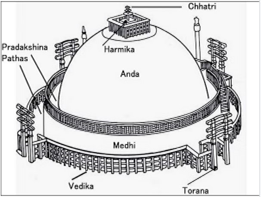TAG: GS-1: ART & CULTURE
CONTEXT: Indian External Affairs Minister stop at the replica of the East Gate of Sanchi’s Great Stupa in front of the Humboldt Forum in Berlin highlights India’s cultural outreach and diplomatic ties with Germany.
EXPLANATION:
About the Sanchi Stupa:
The Sanchi Stupa, located in the Indian state of Madhya Pradesh, is an iconic and highly significant Buddhist monument. Initially commissioned by Emperor Ashoka the Great in the 3rd century BCE, the stupa is part of a large complex that includes other stupas, temples, and monasteries.
- The Great Stupa at Sanchi is one of the oldest stone structures in India and is renowned for its exquisite carvings and elaborate gateways, known as Torana’s, which were added during the subsequent centuries. These gateways are intricately adorned with scenes from the Jataka tales and various events from the life of the Buddha, displaying a remarkable fusion of artistic creativity and religious symbolism.
- The Sanchi Stupa not only stands as a testament to the architectural and artistic prowess of ancient India but also serves as a profound symbol of the spread of Buddhism and its cultural heritage.
Historical Background of Sanchi Stupa:
- Sanchi Stupa was constructed during the reign of Emperor Ashoka, a prominent ruler of the Mauryan Empire. Emperor Ashoka, after embracing Buddhism, became a dedicated patron of the faith.
- He commissioned the construction of numerous Buddhist monuments, including the iconic Sanchi Stupa.
- The initial structure was a simple brick construction. However, subsequent rulers and patrons made additions and embellishments over time.
Features of Sanchi Stupa:
The Great Stupa at Sanchi stands as a towering symbol of ancient craftsmanship and architectural ingenuity. Its massive hemispherical dome has a diameter of 36.5 meters and a height of 16.4 meters.
It dominates the landscape, drawing visitors into its sacred embrace. Surrounding the stupa is a vedika, or fence, delineating the sacred space and separating it from the secular world. The important features of the Sanchi Stupa Architecture have been explained in brief:
- Hemispherical Dome
- The dome of the Great Stupa represents the cosmic Mount Meru. It symbolizes the Buddhist concept of enlightenment and the eternal nature of the universe.
- Toranas (Gateways)
- Adorning the entrances to the stupa are elaborately carved toranas, or gateways. They depict scenes from the life of Buddha and various Jataka tales. These intricately carved sculptures serve as visual narratives, inviting visitors to delve into the teachings of Buddhism.
- Vedika (Fence)
- Encircling the stupa is a vedika, a stone railing adorned with decorative motifs. It further accentuates the sacredness of the site and provides a sense of enclosure.

Some of the major facts about the Sanchi stupa:
- We can see that since the 14th century sanchi remained deserted and undiscovered till 1818 when General Taylor rediscovered the site. Sir John Marshall established an archaeological museum in 1919. Which was later transformed into the present site museum at Sanchi.
- The stupa of sanchi, we can say, especially Stupa 1, it really has a large number of Brahmi inscriptions.
- Architectural Marvel: Features a hemispherical dome (anda), a central pillar (yasti), and a three-tiered umbrella structure (chattra), symbolizing protection of Buddha’s relics.
- Exquisite Toranas: Four elaborately carved gateways (toranas) depict scenes from Jataka tales and Buddha’s life, reflecting intricate artistic skills.
- UNESCO World Heritage Site: Recognized in 1989, underscoring its global cultural and historical importance.
- Ashoka’s Patronage: Symbolizes Ashoka’s significant role in promoting Buddhism and its practices throughout his empire.
- Jataka Tales: Carvings illustrate moral stories and previous lives of the Buddha, contributing to the site’s educational and ethical dimensions.
- Preservation Efforts: Ongoing conservation initiatives ensure the site’s longevity and protection from environmental and human damage.
- Tourism Impact: A key historical tourist destination, contributing to the local economy and global awareness of India’s ancient heritage.
Source:
Spread the Word
